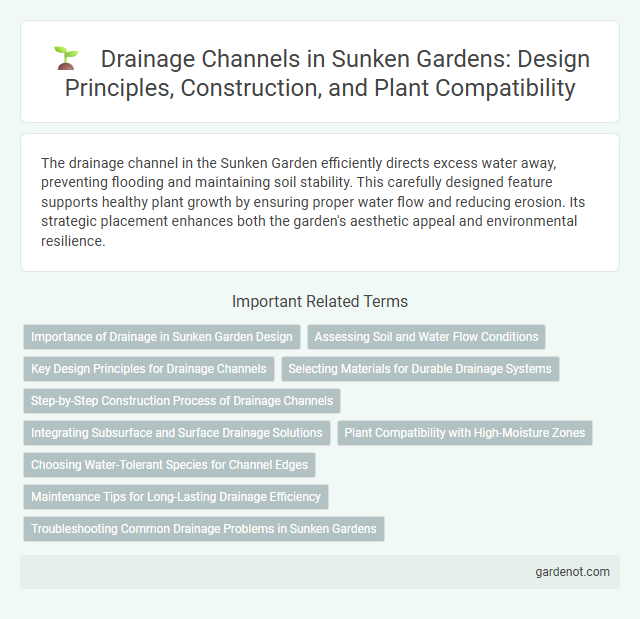The drainage channel in the Sunken Garden efficiently directs excess water away, preventing flooding and maintaining soil stability. This carefully designed feature supports healthy plant growth by ensuring proper water flow and reducing erosion. Its strategic placement enhances both the garden's aesthetic appeal and environmental resilience.
Importance of Drainage in Sunken Garden Design
Efficient drainage channels in a sunken garden prevent waterlogging by directing excess water away from plant roots, ensuring optimal soil aeration and health. Properly designed drainage systems protect the garden's structural integrity by reducing erosion and preventing water accumulation that can damage retaining walls. Incorporating permeable materials and strategically placed channels enhances water flow management, supporting a sustainable and thriving sunken garden ecosystem.
Assessing Soil and Water Flow Conditions
Assessing soil composition and water flow conditions is crucial for designing an effective drainage channel in a sunken garden. Soil permeability, texture, and moisture retention influence water movement and drainage efficiency, while topography determines natural runoff paths. Accurate evaluation ensures optimal channel placement, preventing waterlogging and promoting healthy plant growth.
Key Design Principles for Drainage Channels
Drainage channels in sunken gardens must prioritize efficient water flow to prevent waterlogging and structural damage. Key design principles include appropriate channel slope, durable materials resistant to erosion, and adequate capacity to handle peak runoff volumes from surrounding areas. Incorporating sediment traps and easy access points facilitates maintenance and ensures long-term functionality of the drainage system.
Selecting Materials for Durable Drainage Systems
Selecting materials for durable drainage systems in a sunken garden requires prioritizing corrosion-resistant options like PVC, HDPE, or galvanized steel to withstand constant moisture exposure. Permeable gravel and geotextile fabrics enhance water filtration and prevent sediment clogging, extending system longevity. Proper material choice not only ensures efficient water flow but also reduces maintenance needs and structural damage over time.
Step-by-Step Construction Process of Drainage Channels
Constructing drainage channels in a sunken garden begins with precise site excavation to create a shallow trench that follows the natural slope for optimal water flow. Next, install a layer of gravel or crushed stone to facilitate drainage and prevent soil erosion beneath perforated pipes that collect and redirect excess water. Finally, cover the pipes with more gravel and soil, compacting the surface to blend seamlessly with the garden landscape while ensuring efficient water management.
Integrating Subsurface and Surface Drainage Solutions
In the sunken garden, effective drainage is achieved by integrating subsurface drainage systems with carefully designed surface drainage channels to prevent water accumulation and soil erosion. Perforated pipes installed below the soil surface collect excess groundwater, while gently sloping surface channels direct runoff away from plant roots and hardscape features. This dual approach optimizes water management, ensuring plant health and preserving the structural integrity of the garden.
Plant Compatibility with High-Moisture Zones
Drainage channels in sunken gardens require plants that thrive in high-moisture zones, such as sedges, rushes, and moisture-tolerant ferns. These plant species improve water absorption and help prevent soil erosion by stabilizing the channel banks. Selecting native hydrophilic plants ensures ecological balance and maximizes the garden's drainage efficiency.
Choosing Water-Tolerant Species for Channel Edges
Selecting water-tolerant plant species for drainage channel edges enhances erosion control and improves water filtration in sunken gardens. Native reeds, sedges, and rushes thrive in saturated soils, stabilizing channel banks while supporting local biodiversity. Incorporating these resilient species reduces maintenance needs and promotes sustainable water management.
Maintenance Tips for Long-Lasting Drainage Efficiency
Regularly clearing debris and sediment from the drainage channel in a sunken garden prevents blockages and promotes efficient water flow. Inspecting the channel for cracks or erosion ensures early detection of potential damage and reduces costly repairs. Applying a protective sealant to concrete channels helps extend their lifespan by minimizing water infiltration and structural deterioration.
Troubleshooting Common Drainage Problems in Sunken Gardens
Drainage channels in sunken gardens often face issues such as clogging from debris, soil erosion, and poor water flow, leading to waterlogging and plant stress. Regular inspection and maintenance, including clearing blockages, reinforcing channel linings, and adjusting slopes, are essential to ensure effective water drainage. Using permeable materials and installing sediment traps can enhance drainage efficiency and prevent recurring problems.
Drainage channel Infographic

 gardenot.com
gardenot.com